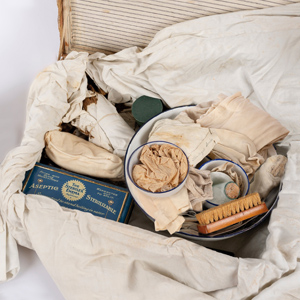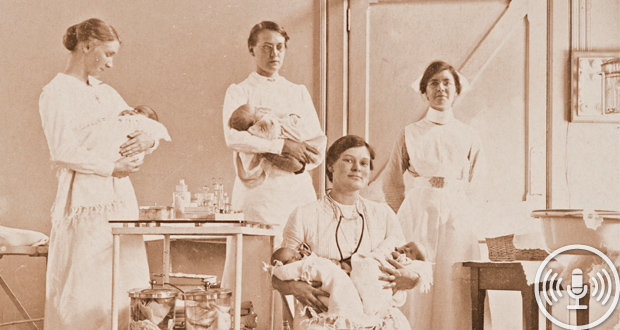The 1850s was a period of immense change in Melbourne. The rush for gold was frantic and in the period between 1850 and 1860 half a million people descend on the area, which only officially came to be known as Melbourne in the 1830s.
The men of the area flocked to the goldfields, leaving women “abandoned – pregnant and destitute”, according to historian Janet McCalman.
The immense wealth and pursuant social upheaval led to a growing number of infants and women dying in childbirth. This set a committee of women on a mission to solve the problem.
The committee – led by Frances Perry and two male doctors, Dr Richard Tracy and Dr John Maund – set to work to establish a facility that would provide universal healthcare and treatment for women.

Florence Green’s midwifery case, 1916; a gift of Margaret and Eric Smith (great-nephew of Florence Green). Photo: Royal Women’s Hospital Collection.
In 1856, the Melbourne Lying-In Hospital and Infirmary for the Diseases Peculiar to Women and Children was established, now know as 'The Women’s'.
A new exhibition at the University of Melbourne’s Medical History Museum, titled The Women's: Carers, advocates and reformers charts the hospital's rise and with it significant medical milestones in Australian history.
Displays include ovariotomy instruments owned by hospital co-founder Dr Richard Tracy and used in Australia’s first ovary operation, the record of the first baby born in the hospital, which was sadly stillborn, and 1880s nipple shields.
Stories also include the ground-breaking role The Women’s played in IVF treatment, after the birth of quads in the 1980s.
Medical History Museum curator Dr Jacqueline Healy joins Nursing Review to talk about the medical history of The Women’s.
Email [email protected]
 Nursing Review The latest in heathcare news for nurses
Nursing Review The latest in heathcare news for nurses

